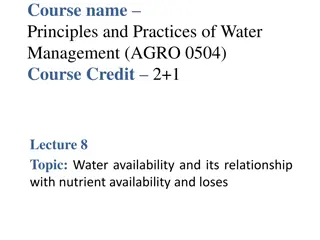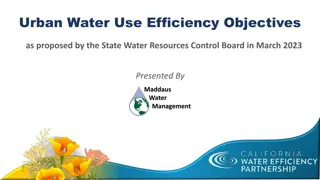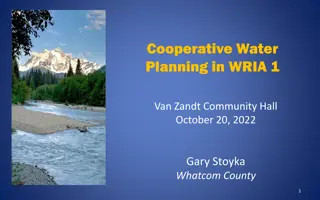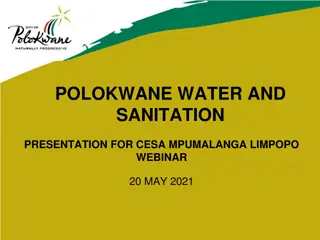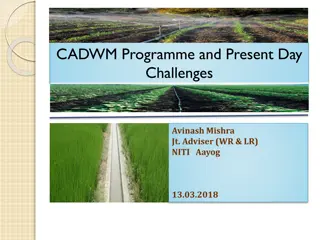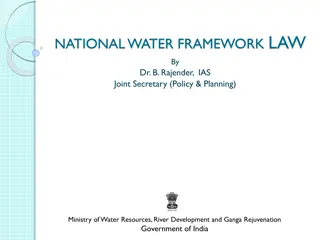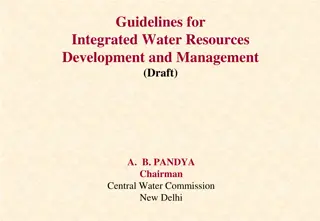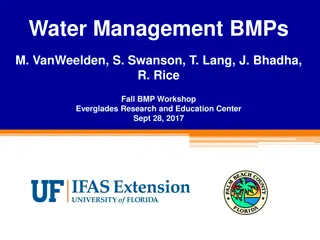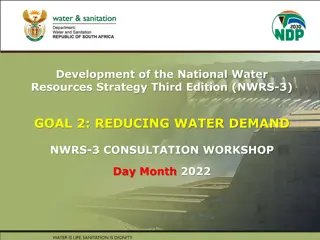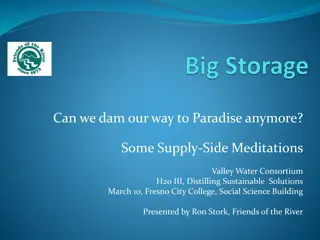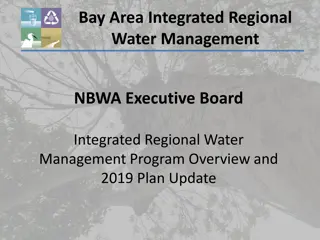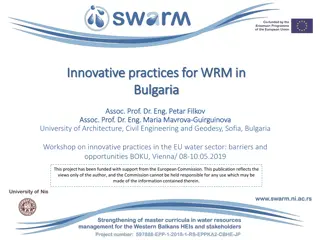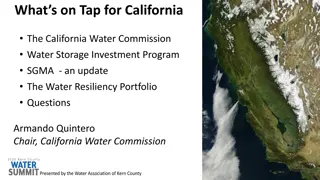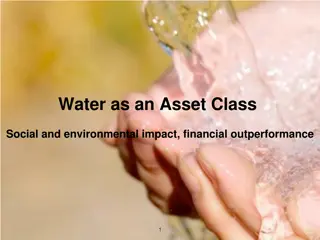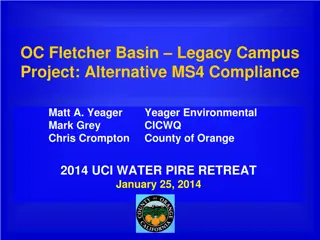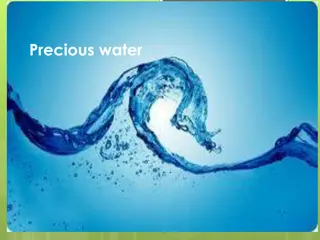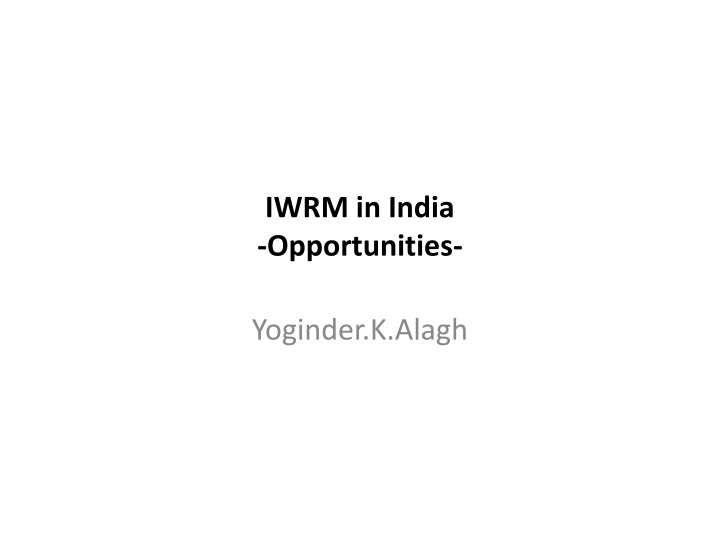
Integrated Water Resource Management in India - Opportunities and Challenges
Development and management in integrated water resource planning in India, focusing on issues such as water resource management, agro-climatic regimes, river basins, and agricultural development. Emphasizes the need for holistic approaches, technological advancements, and community involvement to address water scarcity and achieve sustainable management of natural resources.
Uploaded on | 4 Views
Download Presentation

Please find below an Image/Link to download the presentation.
The content on the website is provided AS IS for your information and personal use only. It may not be sold, licensed, or shared on other websites without obtaining consent from the author. If you encounter any issues during the download, it is possible that the publisher has removed the file from their server.
You are allowed to download the files provided on this website for personal or commercial use, subject to the condition that they are used lawfully. All files are the property of their respective owners.
The content on the website is provided AS IS for your information and personal use only. It may not be sold, licensed, or shared on other websites without obtaining consent from the author.
E N D
Presentation Transcript
IWRM in India -Opportunities- Yoginder.K.Alagh
Scope Some Issues Ignored but may be Relevant: Integrating Water Resources Management with agro climatic regimes; Local Government, CBOs (Community Based Institutions), the management of ponds, water bodies, watersheds, aquifers, and river basins; Soil, Temperature, Rainfall, Agriculture and Basins Estimating Priority Demands and Pricing; Markets and Rationing; Practical Beginnings Technology and Resource Assessments;WRIS; Will Additional(?) Water be Available? Project Planning and Global Best Practices Integrated Water Resources Planning and Implementation
Development and Management In Integrated Water Resource Development and Planning Exercises, hydrological and technical, in the sense of engineering, parameters are well known and detailed. Management in the sense of organizational, networking and financial issues are recognized but seldom detailed, otherwise progress would have been greater on achievement of goals. The view that development should take a back seat and the focus should only be on management is incorrect. India is water short and will have to walk on two legs.
River Basins and Agro Climatic regimes We Plan water Projects in watersheds and basins but the flagship agricultural development Rashtriya Krishi Vikas Yojana (RKVY), said: The state agricultural plan, should be based on (these initial) district plans, subject to reasonable resources from its own plan and adding those available from the centre, aimed at achieving the state s agricultural growth objective, keeping in view the sustainable management of natural resources and technological possibilities in each agro-climatic region (emphasis and paranthesis added).This plan should then determine each district s final resource envelope, their production plan and the associated input plan. The Mid Term Appraisal of the Eleventh Plan had a sober review of this approach. It says that the States have adopted the approach: But convergence of non- governmental programs has been invariably omitted by the states. (GOI, 2010,p.76) The Agro Climatic Plans in the last decade said: Community groups, NGO s and Cooperatives in the Agro Climatic Project have identified the major components. Farmer led distribution systems in existing commands; watershed development rehabilitation of tanks, beels, ponds, talaavs; aquifer management particularly in coastal areas have high returns; But the water and agriculture projects work in silos. Convergence would have high returns as many experiments show.
Agro Climatic Districts and Basins K.V. Raju and Tushar Shah recognise that The physical diversity in India is further accentuated with a definite variation in soils and cultural mores. Agro-Climatic Regional Planning (ACRP) presents itself as an alternate approach for classifying water resources in the country. This method of categorising and classifying water resources employs a utilitarian perspective by subsuming the entire range of land and water resource based activities under the broader range of farming systems (Planning Commission, 1996). Following earlier studies, described earlier, (Deshpande, op.cit. and Alagh, et.al., Planning Commission,1989) they state The ACRP strategy aims at a more scientific utilisation of available resources by taking a holistic view of climate, soil type, topography, water resources and irrigation facilities and relating them to output and employment (Planning Commission, 1989). As a first step in the ACRP approach, the country was regionalised into 15 agro-climatic zones having 73 sub-regions. The zones are delineated so that the regions within the zone have a high degree of commonality on a number of factors ranging from climate, rainfall, water demand and supply characteristics, aquifer conditions to soil types and topography. But River Basins are preferred as a beginning To Raju and Shaw, and like minded scholars, River basins, as is evident from the definition, is a natural division that has physical existence (unlike political and administrative boundaries). Furthermore, river basins occupy the apex of a hierarchy of natural subdivisions like sub-basins, watersheds and micro-watersheds. This is perhaps, the most powerful rationale for the introduction of management of water resources through a river basin approach. Shall we experiment with watershed basins at the lowest level and integrate with agro climatic regimes. We can then move up to larger watersheds and the entire river basin.
A Favourite Example This is from the planning work of SSP. I wanted to see the augmentation of water in convergence of canal and other water conveyance and saving techniques Tank Storage in Shedhi System ________________________________________________________________________________ _____ Year No. of Tanks Deepened New Capacity Creation Range of Deepening (progressive) MCM (m) ________________________________________________________________________________ _____ Season 150 3.5 1 to 6 1993/94 (6.0 to 9.9) By June 1994 254 6.0 0.25 to 9.3 ( 9.0 to 13.9) ________________________________________________________________________________ _____ 14 % additional water cannot be considered trivial in a water short context. It is interesting that the Shedhi Branch of the Mahi system was planned on the basis that there are no tanks in the system.
Watersheds and River Basins Action on solving water problems has to be at the local, watershed, aquifer, State and river basin level. This has to be the guiding mantra of Planning, Project Formulation and Execution. But it should not remain just a Mantra. What are the mechanisms to give strength to the local, State, watershed and river basin level . Cutting edge frontier technology in water delivery and development projects has to be developed at home and accessed in the World and made available. Working Best Practices must be known and diffused. Development and applications of success stories will require data and information support. We have to set up the systems to aid the State Governments, Local Bodies and CBOs in these support mechanisms. But all the action cannot be harmonious. There are conflicts and disputes. We have to work on the relevant aspects of the role of the national government in the complex area of dispute resolution. In a federal setup this has to be a national task. Again experienced based solutions need to be looked at. Asked to arbitrate in a season s dispute on water sharing in a river basin, following the Apex Courts directive, I had also suggested that a three layer system implemented in the Mekong Basin amongst nations which had actually gone to war with each other be designed. This system, at the highest level political, at the second level coordinative and at the third level a delivery apparatus, was implemented and has worked reasonably well. These problems need constant attention. It has been structured weakly but is still creaky. Shall we plan some case studies and sample projects in these areas?
Magnitudes Climate Class Water Balance Code Number of Districts % Land Area Moisture Index Soil Climatic Zones in India Source: Krishnan (1988, p.16). Extremely Arid Arid Semi-Arid (Drier Half) Semi-Arid (Wetter Half) Dry Sub Humid Total Negative MI Districts Moist Sub Humid Humid Per Humid Total Positive MI Districts All Districts A B C D E 7 24 97 53 107 288 37 35 37 26.3 397 9.3 6.3 21.9 15.1 21.1 73.7 10.2 7.8 8.3 < -80 -80 to -66 -66 to -50 -50 to -33 -33 to 0 F G H 109 0 to + 20 +20 to +100 > + 100 100
Canals The delivery efficiencies of canal based irrigation in India is poor. Wastage of water is high and irrigation is generally not controlled leading to severe restrictions in cropping and technology choices. Studies show that farmer managed modernization and operation programs for levels below a distributary can double irrigation efficiencies. It should be possible to extend this program to a million hectares. The existing systems act as a drag. Irrigation authorities are loath to decentralize power. Planning Commission sponsored studies show that even in canal modernization schemes, when farmers are encouraged to manage canal systems, irrigation authorities keep most powers to themselves and if responsibilities are decentralized, resources for operation and maintenance are not. The only alternative model which I know which is seriously suggested is the plea that the Chinese experiments in private sector institutions at the village level to run water systems should be the preferred model. Incidentally this model also includes a strong system upstream say up to the distributary as we would call it. Also I think it underestimates the role of the Communist party in directing public-private partnerships in China. My impression after field visits in rural areas leading a Rajiv Gandhi Foundation delegation in October 2004, was that the local agents are carefully selected and are responsible to higher authorities. It is not an accident that The Mayors of Shanghai go to Beijing at the highest levels. The model cannot be copied without adjustment
Replicating Successes There are successful models in India. They require that the ownership and operation of the systems say at the level of a minor or below is left to an organization of the farmers in the command. In addition the existing resources for operation and maintenance have to be transferred to the Farmers group. This has to be done by law in the sense that government orders have to be issued requiring the transfer in practice. More often than not the principle is accepted but the practice is not there. There are many successful examples. A few years ago a meeting was held at the Development Support Center(DSC) at Bopal in Gujarat where the results of different experiments in handing over lower level irrigation systems to farmers groups were discussed in the presence of the then Member of the Planning Commission, Shri B.N.Yugandhar and Y.K.Alagh. The design of such experiments both in physical control systems, operations and more important legal and rule based changes are available with the DSC. Shall we Revive these experiments?
Who Will Do It ? Community groups, NGO s and Cooperatives have been identified for the major components. Farmer led distribution systems in existing commands; watershed development rehabilitation of tanks, beels, ponds, talaavs; aquifier management particularly in coastal areas have high returns; A massive program for land and water development has to be the centre piece. Growth of private investment in groundwater has been spectacular and needs further support, particularly in the Eastern region and in Peninsular India Basin Development and transfer of water are important. It must be led by a public policy initiative, with a very large financing component. Newer institutional forms like cooperatives, NGOs, non profit companies and Producer Companies, have all worked. PPPs must be designed. Private Participation with Regulation must be supported. Leadership groups must supervise the preparation and implementation of such programs at the regional level of 3 to 5 Districts.
Canals and Groundwater Conjunctive water use can be attempted in an an area and is well suited to describe the dynamic interaction between the surface and subsurface water systems ( Peter Millington, 1996 ). The flow chart of a simple multi level model can be as follows: Water --------------------- irrigation,trees,etc Development \ \ \ \ \ \ \ \ \ \ Wells Drilled \ \ Climate Regime --- Water Table \ Depth ----------------------- \ / \ / \ / Ground Water Quantity Source: Nicholas Sonntag (1996) Population; Needs, Deep Aquifier Water Quantity
APFAMGS of Course We need to develop sustainable groundwater management plans for each aquifer. This requires action on the ground involving partnerships of stakeholders at the village level with hydro geologists social mobilizers and companies, who would guide collective sharing and sequential use of groundwater based on a careful understanding of the storage and transmission characteristics of different aquifers in each of the hydrogeological settings outlined in the MTA of the XIth Plan. Promising work on a reasonable scale has started in this direction in Andhra Pradesh. The Andhra Pradesh Farmer Managed. Groundwater Systems (APFAMGS) project was supported by the Food and Agriculture Organization and implemented by NGOs in seven drought prone districts of Andhra Pradesh. The project employs participatory hydrogeological monitoring, by engaging farmers in data collection and analysis, and building their understanding of the dynamics and status of groundwater in local aquifers. This is complemented with crop water budgeting, whereby the quantity of water required for crops is assessed at the aquifer level and compared with the amount of groundwater actually available to arrive at a suitable cropping pattern that would permit sustainable groundwater use. The total outreach of the program is estimated at 1 million farmers. Such initiatives need to be undertaken at many more locations in the Twelfth Plan.(Details of this program are available in Alagh, Yoginder.K., 2009, FAO, which high lights the APFAMGS and the Plan documents now own this program but it is not expanding at the required pace.) As Oliver Twist said Can I have some more sir.
My Biases SSP -Lets Do It- Some of the unique features built into the planning of the project are concrete-lined canals to reduce conveyance losses, use of control volume concept for design of distribution systems, efficient water use allocation with optimised crop planning for 13 different agro-climatic zones of the command, extensive irrigation to a 180,000 ha area with just 21 delta supported by the use of 8 of groundwater , deepening of village tanks for borrowing soils for canal embankments, computerised automated operation of canal system, participatory irrigation management through Wager Users Associations, and promoting micro-irrigation systems like drip and sprinkler for efficient water use. (S. Jagadeesan, 2012, p.901). Its not done yet. But Scarcities have now Started. So now shall we do it? Experiment in a Distributory with IWRM
Canals and the Last Mile In the SSP system, canals were designed to deliver controlled water and depending on his(er) cropping pattern the farmer would draw ground water in each region, The actual design showed that canal water use would vary inversely with groundwater use The system was designed such that the private sector could participate in it. The Design needs implementation and replication Shall we repeat the Shedi experiment for a lot has changed since?
Water Demand The IWRM has to provide that every individual has a right to a minimum quantity of potable water for essential health and hygiene and within easy reach of the household. The state s responsibility for ensuring people s right to water has to remain despite corporatization or privatization of water services and the privatization of the service, where considered necessary and appropriate, should be subject to this provision. The Falkenmark Index is there and yet the minimum need for human consumption is a question. For the human consumption aspect a globally accepted norm does not exist. In developing countries, the question of water for animals becomes a vexed issue and the Government of India references Cullet gives are select program features and not minimum needs in a universal sense. In fact, the earlier minimum needs plans only talked about the availability of a drinking water source and quantities of flows were not stated. In fact, apart from exceptions like Bengaluru, measured quantities of water deliveries were not known in India. Having chaired the Task Force which defined India s Poverty Line which continues upto today since the Tendulkar Committee did not set down a new criteria but decided that the Alagh Urban Poverty Line should be the National Poverty Line and Rangarajan also did not change. We have been asking for a new definition since the Nineties of the last century, This has not been done. However, practical problems cannot await resolution of these issues. We may follow the approach operationalized in the Food Security legislation and described by experts like Abhijit Sen and others like us. The Food Security legislation has the approach of keeping the norm low but coverage universal. The low norm is a minima which can and is, expected to be exceeded in most cases. Thus, if the minimum norm directs a certain minimum quantity of grain to be delivered at a minimal price, the rest is expected to be made up by the State Governments and from the savings achieved by poor households when some grain is delivered free. The pregnant woman is not given a glass of milk and the girl child an egg, but the legislation is a step in that direction. The minimum water norm for human consumption will need to be enforced by law even at 2000 meters above sea level in the Himalayas or in the desert. It is a minimum. It is possible to build up dual pricing models where some water is given free(life supporting) and the rest is priced. (For a discussion of this see Yoginder.K.Alagh, More on MOST,UNESCO, 2002.) Communities can be asked to enforce these systems.
WRIS A new research effort at integrating water resource assessment work with agro-climatic regional categories and that of improving the precision of the estimates and setting the base for more work on the features which augment the availability of fresh water in a renewable manner. Apart from institutions, it sets down categories corresponding to agro-climatic concepts defined in a regional context, simultaneously modelling water availability. Surface-groundwater interaction models are by now common. It is being suggested that such modelling should be attempted more systematically, not in only in response to project formulation work, but with instruments of a water conserving or water augmentation nature built in. Farmer Managed systems, conjunctive use and holistic management of local water bodies are examples In a three to five year framework, it should be possible to generate knowledge, from which generalisation could begin. It is extremely likely that assessments of water as a resource will gain another dimension if such efforts are pursued.
Lots to Do Before we sleep! The woods are inviting and deep. Lots to do before we sleep. Thank You. Jai Hind





